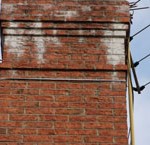 Have you looked at your masonry chimney lately?
Have you looked at your masonry chimney lately?
If so you have probably noticed some discoloration throughout the chimney brick or stone, particularly in the upper portion of the structure. This is a sure sign of excessive water infiltration into the chimney shell and if not taken care of can lead to costly damage with premature deterioration.
Excessive water in a chimney shell can manifest in three ways: efflorescence, mold growth and spalling. One or two of these symptoms could be visible on your chimney or all three depending on the severity of the problem. Let’s take a look at each of these symptoms and the recommended solutions, so that you can protect your chimney from un-wanted damage.
Efflorescence – Efflorescence is a white power that is visible on the surface of the brick or stone (masonry) of your chimney shell. Water that is inside of a chimney will dissolve soluble salts in the brick and mortars. As the water migrates to the outside surface of the chimney by wicking action it carries these soluble salts with it and then deposits them on the surface of the masonry during evaporation.
Solution: An application of a heavy degreaser or detergent as purchased from a pressure washing supply company will usually do the trick in removal of most surface molds. Soak the chimney with a hose before applying the detergent then let set for approx. fifteen minutes. Then use a pressure washer to remove the detergent and the mold.
Spalling – Spalling is the action of the de-lamination of the face of brick or stone masonry unit. It is caused by excessive water within the pores of the unit freezing and thawing over hundreds of cycles. The constant freezing action breaks the pores of the brick apart and causes the face to fall off.
All three of these problems can be prevented by the installation of a quality chimney crown. Talk to your masonry professional for additional information.























